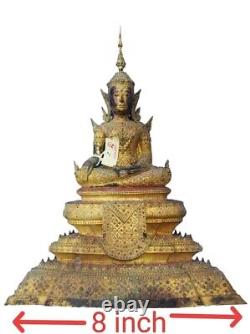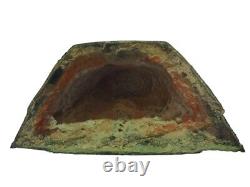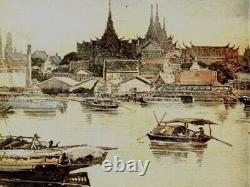Thai amulet Buddha Antique 19th Century 3 Rattanakosin Gold Gilt Bronze #6








Practices and Agreements for Purchasing Buddha Statues. To comply with Thailand export laws. We will use your name and address to process the legal ownership of the goods. The document processing period will take no more than 15-20 days. Everything will proceed in accordance with the laws of exporting Thai antiques.
The total processing time will not exceed 25 days. All this is to enable customers or buyers to possess and own Thai Buddha statues and antiques with legal rights. Thank you to all customers.
Thai Buddhist Rattanakosin style Bronze. Older Siam Thailand 150 - 242 years. One (1) large antique Thai seated Buddha.Well detailed cast bronze coated with red and black lacquer then gold gilt. There may be traces of chipping of the lacquer and gold covering in some places, resulting in a black color due to the passage of a long period of time, which is a natural phenomenon of antiques. Size measured from the base (lap width) 3 inches. There is a genuine inspection from an amulet. We deliver products by Thailand Post.
The story and the divine power of this amulet. The Rattanakosin period began in 2325 BE. His Majesty King Rama I, the founder of the Chakri Dynasty, ascended the throne and established Rattanakosin or Bangkok as the capital of Siam.
He devoted most of his time to building the country to prosperity, including promoting Buddhism by ordering the invitation of Buddha images from the northern cities to be renovated and then enshrined as the principal Buddha images in the ordination halls of various monasteries, totaling 1,248 images. Therefore, Buddha images at that time included Sukhothai, U Thong, and Ayutthaya styles. There were no Buddha images of each era yet. It was not until the reigns of King Phra Phutthaloetla Naphalai, King Rama II, and King Nangklao, King Rama III, that the creation of Buddha images began, marking the beginning of the Rattanakosin Buddha images.The tradition of creating Buddha images or amulets in ancient times It is created for the sake of merit in the next life and to continue Buddhism. It is popular to create a total of 84,000 statues, equal to the number of Dhammakkhandha, and then place them in the pagoda or under the base of the principal Buddha image, etc.
As can be seen, excavations of Buddha statues and amulets from various eras have usually been found in the aforementioned places. However, for "Buddha statues from the Rattanakosin period", Buddhists like to create them to offer to temples and monasteries as a way to continue spreading Buddhism.

